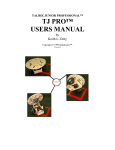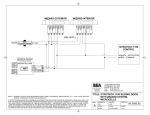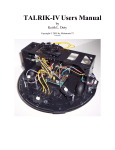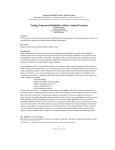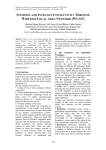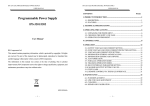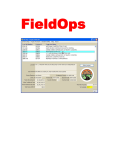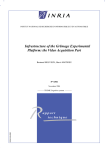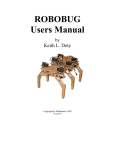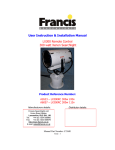Download Project1_Piednoir_Perrin_Lemarchand_Izaac
Transcript
IZAAC / LEMARCHAND / PERRIN / PIEDNOIR January the 23th 2003 Design of Differential Encoders for the Talrik II Robot Design of Differential Encoders for the Talrik II Robot Georgia Tech Lorraine, School of ECE January the 24th 2003 ECE 8873 / Project 1 Dr. HECK Marie-Laure PIEDNOIR Nicolas PERRIN Ronan LEMARCHAND Jérôme IZAAC ECE 8873 Georgia Tech Lorraine, School of ECE -1- IZAAC / LEMARCHAND / PERRIN / PIEDNOIR January the 23th 2003 Design of Differential Encoders for the Talrik II Robot Abstract The Talrik II robot has two motorized wheels, and a third one which follows the move of the two others. When we want the robot to go straight forward or straight backward, we need to apply exactly the same command to the two motors, and when we want it to turn on the right or on the left, we have to make a wheel turn faster than the other. This is really simple in theory, but in facts we cannot always be sure of what we send to the motors, and, more important, how they react. In order to automate the motion, we need a feedback; this means that we have to know at each time the angular speed of each motor, to control if the robot follows the desired path. That is the reason why we decided to add two coders on the motorized wheels. Each coder, after being mounted on the axis of each motor and wheel, sends a signal that can be measured and computed by the micro controller in order to find the speed at which each wheel rotates. This report will explain which encoders and encoding wheels will be mounted on the Talrik II robot, the way to fix them to the axes and to make them communicate to the Motherboard of our robot, and an explanation on how to retrieve the position and the speed of our robot, analysing the signals emitted by them. ECE 8873 Georgia Tech Lorraine, School of ECE -2- IZAAC / LEMARCHAND / PERRIN / PIEDNOIR January the 23th 2003 Design of Differential Encoders for the Talrik II Robot Abstract ...................................................................................................................................... 2 I. Incremental encoder principle............................................................................................ 4 II. Choice of the encoder......................................................................................................... 9 A. B. Category 1: encoders whose price is higher than 100 Euros.......................................... 9 Category 2 : encoders whose price is lower than 30 Euros......................................... 11 1. Example 1: HEDS-5500........................................................................................... 11 2. Example 2: 120EN-128-C24 .................................................................................... 12 C. Category 3: encoders whose price is between 30 Euros and 100 Euros ...................... 13 1. Example 1: HEDS-9000........................................................................................... 13 2. Example 2: HEDS-9040 and HEDS-9140 ............................................................... 14 III. A. B. IV. A. B. C. D. V. Physical description of the measure module ................................................................ 15 Physical constraints ...................................................................................................... 15 Solution proposed......................................................................................................... 16 Interfacing encoder with the robot – Electrical constraints.......................................... 19 Electrical constraints of the encoders........................................................................... 19 Constraints of the robot ................................................................................................ 20 Solution ........................................................................................................................ 21 Interfacing the encoders with the robot........................................................................ 22 1. Interface board MSCC11 with the robot .................................................................. 22 2. Connect encoders to MSCC11 board ....................................................................... 23 The algorithm ................................................................................................................... 24 A. B. C. D. VI. How to count the ticks?................................................................................................ 24 How to measure the position........................................................................................ 25 How to measure the speed............................................................................................ 26 Program for the onboard computer .............................................................................. 27 Ordering ....................................................................................................................... 28 Conclusion................................................................................................................................ 30 ECE 8873 Georgia Tech Lorraine, School of ECE -3- IZAAC / LEMARCHAND / PERRIN / PIEDNOIR January the 23th 2003 Design of Differential Encoders for the Talrik II Robot I. Incremental encoder principle An incremental encoder system is a sensor that detects movements through optical detections of holes. It is composed of two parts: the code wheel and the encoder. The code wheel is a piece of metal on which are regularly pierced holes on its outline: Scheme : Wheel Holes Coder The code wheel goes inside the encoder in which the holes are tested. To test if a hole is present or not, a source light is present on a side of the wheel and a photodiode is on the other side. The logical level of the electrical signal changes if the photodiode receives light or not. Volts Volts time Hole time no Hole When the wheel rotates, holes and solid parts pass between the photodiode and the light source. The signal emitted by the photodiode switches between high and low logic level: Volts time Assuming the wheel rotates in only one way, the measure of the rotation done by the wheel can be deduced by counting the number of state’s changes of the signal. ECE 8873 Georgia Tech Lorraine, School of ECE -4- IZAAC / LEMARCHAND / PERRIN / PIEDNOIR January the 23th 2003 Design of Differential Encoders for the Talrik II Robot Assuming the wheel has a constant speed, the speed can be deduced by measuring the frequency of the signal’s fundamental. The previous paragraph has shown how the position and the speed of a one way rotating wheel can be measured. Now we will explain how the direction of the wheel can be measured. A second device (light source/photodiode) is added but shifted in space. Therefore the signal it emits is shifted in time A B A B 1 A B 2 So the second signal is out of phase by +90 degrees or -90 degrees depending on the way the wheel is rotating. ECE 8873 Georgia Tech Lorraine, School of ECE -5- 3 IZAAC / LEMARCHAND / PERRIN / PIEDNOIR January the 23th 2003 Design of Differential Encoders for the Talrik II Robot Direct way (the wheel moves in the way of the arrow of the previous scheme): Volts on channel A time Volts on channel B time 1 2 3 Reverse way (the wheel moves in the opposite way of the arrow): Volts on channel A time Volts on channel B time 3 2 1 The most common way to measure the difference of phase is to measure the logical state of one of the channels each time the other channel change its state. An example is shown on the following diagrams where Trigger is written: the measure of the logical state of the channel B is triggered by the rising front of the channel A. To save this data, a flip/flop can be used to store the measured value. Signal of channel B DATA OUTPUT Signal of channel A Signal of the Direction of the wheel CLOCK triggered on rising front Flip-Flop Depending on the way the wheel is spinning, the signal of the direction remains on low or high level between each time the flip-flop is triggered. If the wheel rotates in one constant way, the direction signal will remain on the same logical level. ECE 8873 Georgia Tech Lorraine, School of ECE -6- IZAAC / LEMARCHAND / PERRIN / PIEDNOIR January the 23th 2003 Design of Differential Encoders for the Talrik II Robot Direct way (the wheel moves in the way of the arrow): Volts on channel A time Volts on channel B time Volts on Direction Trigger time Trigger Reverse way (the wheel moves in the opposite way of the arrow): Volts on channel A time Volts on channel B time Volts on Direction Trigger time Trigger However we could also use the micro controller of the Talrik II to measure the direction of the wheels by analyzing the channels A and B. There is no difference between the two solutions, concerning the connections: each of them uses two pins. Computer Computer Direction Flip/Flop Channel A Channel B Channel A Encoder Channel B Encoder ECE 8873 Georgia Tech Lorraine, School of ECE -7- IZAAC / LEMARCHAND / PERRIN / PIEDNOIR January the 23th 2003 Design of Differential Encoders for the Talrik II Robot Between the two solutions we have chosen to use the hardware detection of the direction for the following reasons: • The hardware solution spares computing time on the onboard computer. • The Flip/Flop prize is very low (and it save software development costs). So, the price difference between the two solutions is small. ECE 8873 Georgia Tech Lorraine, School of ECE -8- IZAAC / LEMARCHAND / PERRIN / PIEDNOIR January the 23th 2003 Design of Differential Encoders for the Talrik II Robot II. Choice of the encoder The constraints are the following: • We need two encoders (one per wheel). • Each encoder must provide two channel quadrature outputs (channels A and B). • The precision on the position of the robot must be below two centimeters. • The voltage supply of the encoder must be a single 5V supply, since the voltage provided by the robot for the captor is a single 5V supply. • The component must fit in the physical space that is available on the robot. (See: III.Physical description of the measure module) • The price of the component should not be too high. Based on their price we categorize three different types of optical encoders. We will now underline the main characteristics of each category and the criteria of choice that will help us to select one of the available encoder. The three categories are: • the encoders whose price is higher than 100 Euros • the encoders whose price is between 30 Euros and 100 Euros • the encoders whose price is lower than 30 Euros A. Category 1: encoders whose price is higher than 100 Euros These optical encoders offer a very high precision. They are easy to set up since they are already assembled. However they are clearly unaffordable. Moreover we must consider that we need one encoder per wheel so the price should be multiplied by two. ECE 8873 Georgia Tech Lorraine, School of ECE -9- IZAAC / LEMARCHAND / PERRIN / PIEDNOIR January the 23th 2003 Design of Differential Encoders for the Talrik II Robot Here is an example of an optical encoder of this category: Figure: RI58-S/0360AS.41KBPG Price: 385.7 Euros Reference: RI58-S/0360AS.41KBPG Features (taken from the datasheet): universal industrial encoder up to 40,000 step with 10,000 pulses high signal accuracy flexible due to many flange and connectors variants suitable for high shocks loads The datasheet of the component is available at: www.farnell.com/datasheets/27383.pdf It is needless to consider more precisely the encoders of this category, since their prices prevent us from choosing them for our design. Conclusion: the encoders of this category should not be chosen. ECE 8873 Georgia Tech Lorraine, School of ECE - 10 - IZAAC / LEMARCHAND / PERRIN / PIEDNOIR January the 23th 2003 Design of Differential Encoders for the Talrik II Robot B. Category 2 : encoders whose price is lower than 30 Euros This category of encoder is mainly composed of encoders whose prices are typically between 40 Euros and 50 Euros. These encoders have the advantage of being already assembled. Obviously their characteristics are not as good as those of the encoders of the category 1, but are still acceptable. Let us consider some encoders of this category: 1. Example 1: HEDS-5500 Figure: HEDS-5500 Price: 44.97 Euros Reference: HEDS-5500 Features (taken from the datasheet): two channel quadrature outputs quick and easy assembly no signal adjustments required resolution up to 1024 counts per revolution single 5V supply The datasheet of the component is available at: http://www.farnell.com/datasheets/7725.pdf ECE 8873 Georgia Tech Lorraine, School of ECE - 11 - IZAAC / LEMARCHAND / PERRIN / PIEDNOIR January the 23th 2003 Design of Differential Encoders for the Talrik II Robot 2. Example 2: 120EN-128-C24 Figure: 120EN-128-C24 Price: 39.39 Euros Reference: 120EN-128-C24 Features (taken from the datasheet): two channel quadrature outputs 128 counts per revolution single 5V supply The resolution of the encoder depends on the number of counts per revolution. With this encoder we can see that the cheaper it is, the lower the resolution is. The datasheet of the component is available at: http://www.farnell.com/datasheets/5064.pdf Conclusion: The encoders of this category could be chosen. Although they are not the cheapest ones, they are not too expensive and their main advantage is to be already assembled, which makes them easier and quicker to mount. ECE 8873 Georgia Tech Lorraine, School of ECE - 12 - IZAAC / LEMARCHAND / PERRIN / PIEDNOIR January the 23th 2003 Design of Differential Encoders for the Talrik II Robot C. Category 3: encoders whose price is between 30 Euros and 100 Euros The different encoders grouped in this category are the cheapest encoders we could find. These encoders are not assembled and this is the main reason why they are low cost components. 1. Example 1: HEDS-9000 Figure: HEDS-9000 Price: 22.55 Euros Reference: HEDS-9000 Features (taken from the datasheet): two channel quadrature outputs 2000 counts per revolution single 5V supply small size easy to mount no signal adjustment required ECE 8873 Georgia Tech Lorraine, School of ECE - 13 - IZAAC / LEMARCHAND / PERRIN / PIEDNOIR January the 23th 2003 Design of Differential Encoders for the Talrik II Robot The datasheet of the component is available at: http://www.farnell.com/datasheets/2616.pdf 2. Example 2: HEDS-9040 and HEDS-9140 The appearance of these encoders is exactly the same as the encoder HEDS-9000. The main differences are the following (taken from the datasheet): The HEDS-9040 and HEDS-9140 are three-channel optical incremental encoder modules. These modules provide the same performances found in the HEDS-9000 two-channel encoder. The HEDS-9040 and 9140 have two channel quadrature outputs plus a third channel index output. The output of channel I (index) is an index impulse which is generated once for each full rotation of the code wheel. Price: 24.97 Euros Reference: HEDS-9040 Features of the HEDS-9040 (taken from the datasheet): two channel quadrature outputs and index impulse 2000 counts per revolution (So the precision constraint is repected) single 5V supply small size easy to mount no signal adjustment required The datasheet of the component is available at: http://www.farnell.com/datasheets/6186.pdf Conclusion: We have decided to choose the component HEDS-9040 because it is one of the cheapest encoders that we found. Moreover with this component we also have an index pulse that could be useful in the future. ECE 8873 Georgia Tech Lorraine, School of ECE - 14 - IZAAC / LEMARCHAND / PERRIN / PIEDNOIR January the 23th 2003 Design of Differential Encoders for the Talrik II Robot III. Physical description of the measure module A. Physical constraints The motorized wheels have an environment as described in the following picture (Picture taken from under the robot): Wheel Motor 74 mm 5 mm ECE 8873 Georgia Tech Lorraine, School of ECE - 15 - IZAAC / LEMARCHAND / PERRIN / PIEDNOIR January the 23th 2003 Design of Differential Encoders for the Talrik II Robot B. Solution proposed We first looked for an incremental encoder tiny enough but with a reasonable prize. The space between the motor and the wheel is very limited: 5 mm The code wheel has a diameter of 25, 4 mm and is hollowed for a 4 mm diameter axis. The dimensions of the coder/code wheel are shown on the following diagram 25.4 mm ECE 8873 Georgia Tech Lorraine, School of ECE - 16 - IZAAC / LEMARCHAND / PERRIN / PIEDNOIR January the 23th 2003 Design of Differential Encoders for the Talrik II Robot To add the code wheel and the encoder, we have to match two main constraints, which are to fix the encoder and to prevent the wheel from moving out of its axis Any misalignment of the code wheel and the encoder would result in inaccurate measures. To prevent any tilt from the wheel we will add a longer axis that will be fixed on a base fixed on the Talrik II through existing screws and bolts. The base will also be used to fix the encoder. The following picture shows the base. It is made of pieces of wood. 22 mm 20.96 mm 90 degrees 9 mm 28.15 mm 11 mm Note: only the measures shown on the above picture are important for the measure precision. ECE 8873 Georgia Tech Lorraine, School of ECE - 17 - IZAAC / LEMARCHAND / PERRIN / PIEDNOIR January the 23th 2003 Design of Differential Encoders for the Talrik II Robot Here is a diagram of the assembly of the axis (in red) the base (in green), the encoder (in blue), the code wheel (in dark grey) to the Talrik II: The following picture shows the measure device once assembled on the Talrik II: ECE 8873 Georgia Tech Lorraine, School of ECE - 18 - IZAAC / LEMARCHAND / PERRIN / PIEDNOIR January the 23th 2003 Design of Differential Encoders for the Talrik II Robot IV. Interfacing encoder with the robot – Electrical constraints Now that we have decided to use 2 encoders HEDS-9040 – one for each motorized wheel – we have to find out how to interface them with the robot. A. Electrical constraints of the encoders The HEDS-9040 datasheet provides the following electrical configuration: (Taken from HEDS-9040 datasheet) As shown above, each encoder has 5 pins: - Pin 1 or ground pin, - Pins 2,3 and 5 or I, A and B digital outputs, - Pin 4 or Vcc pin. It is also explained in the datasheet that the encoder requires 3 2.7 kΩ (+/- 10 %) pull-up resistors (one for each digital output) as shown above on the picture. These pull-up resistors should be placed as close as possible to the encoder itself (within 4 feet). ECE 8873 Georgia Tech Lorraine, School of ECE - 19 - IZAAC / LEMARCHAND / PERRIN / PIEDNOIR January the 23th 2003 Design of Differential Encoders for the Talrik II Robot Datasheet also provides the following encoder’s electrical characteristics array: (Taken from HEDS-9040 datasheet) Line 2 shows that each encoder requires a typical Vcc about 5V. Here is a summary of electrical constraints brought by the encoders: - Type of outputs: Channels A, B and I are digital outputs. - Power requirements: Vcc = 5V. - 3 2.7 kΩ (+/- 10 %) pull-up resistors to be mounted between I, A and B outputs and Vcc. B. Constraints of the robot The robot is composed of 2 main boards: - Processor board MRC11, - Sensor expansion board MRSX01. As for the robot’s internal communication system between components, processor board comes with a 60-pin male header processor I/O bus. This bus communicates with MRSX01 board through a ribbon. MRSX01 board features 20 analog inputs and 2 digital inputs. Talrik II communicates through logic signals: 5V and ground, coding the 2 logical states 1 and 0. ECE 8873 Georgia Tech Lorraine, School of ECE - 20 - IZAAC / LEMARCHAND / PERRIN / PIEDNOIR January the 23th 2003 Design of Differential Encoders for the Talrik II Robot Also, when needed, up to 2 sensor expansion boards MSCC11 can be mounted on the robot. Each board comes with 8 analog I/O channels and 8 digital inputs. It communicates with MRC11 board via Serial Peripheral Interface or Serial Communications Interface. MSCC11 board provides the following information: Each digital input is made of 3 pins: one Vcc pin, one signal pin and one ground pin, where Vcc = 5V. C. Solution Now we are going to see if the constraints of the encoders are compliant with the robot’s ones. As we use 2 encoders we need 4 digital inputs on the robot (A and B channel from first sensor, A and B channels from second sensor). But the robot initially has only 2 digital inputs (on MRSX01 expansion board as explained previously). Thus we need to add one expansion board MSCC11 on the robot. These digital inputs fit the 5V-Vcc requirements. Regarding the ordering of MSCC11 board, there are 2 possibilities: - Buy non-assembled board, price 30 $, - Or buy already assembled board, price 66 $. Also, as we use 2 encoders we need 2*3 = 6 2.7 kΩ (+/- 10 %) pull-up resistors. These can be ordered at Farnell. We also need some material to mount MSCC11 board, a 6-wire C2325 ribbon connect it to the robot and a 6-AA NiCd battery pack to power it up. To sum up, we need the following to interface encoders with the robot: - One additional MSCC11 sensor expansion board, 30 or 60 $, - 6 2.7 kΩ (+/- 10 %) resistors, - one 6-wire C2325 communication ribbon, - a 6-AA NiCd battery pack ECE 8873 Georgia Tech Lorraine, School of ECE - 21 - IZAAC / LEMARCHAND / PERRIN / PIEDNOIR January the 23th 2003 Design of Differential Encoders for the Talrik II Robot If we choose to order non-assembled MSCC11, we should make sure we also have the following material (as quoted in MSCC11 assembly manual posted on MEKATRONIX’s website): “ - Soldering iron, - 60/40 rosin core 0.032 diameter electronics solder, - Small diagonal cutters for cutting wire and headers, - Needle nose pliers, - Wire stripers, - Hot glue gun and hot glue, - Masking tape. “ D. Interfacing the encoders with the robot 1. Interface board MSCC11 with the robot • Communicate with the MRC processor board MSCC11 additional board needs to be linked to MRC11 processor board to communicate with the main program and send it data from the 2 encoders. As said before, MSCC11 communicates with MRC11 through Serial Peripherical Interface (SPI) or Serial Communications Interface (SCI) via a 6-wire C2325 MEKATRONIX™ ribbon. We decide to make them communicate via SCI. The ribbon should connect J54 plug on MSCC11 board to SCI jumper on MRC11. The ribbon can be purchased on www.mrrobot.com assembled or not. ECE 8873 Georgia Tech Lorraine, School of ECE - 22 - IZAAC / LEMARCHAND / PERRIN / PIEDNOIR January the 23th 2003 Design of Differential Encoders for the Talrik II Robot Here are the current descriptions and prices found on the website: “ C2325a: 6-Wire Serial Ribbon Cable: 6 ft long with 1x6 female connectors on each end. Price: 9.95 $ C2325u: 6-Wire Serial Ribbon Cable KIT: 3 ft of ribbon wire + connector(s) to make the C2325a. Price: 4.95$ ” • Supply power to the MSCC11 board When reading MSCC11’s assembly manual, we find out that MSCC11 is powered up using a 6-AA NiCd battery pack connected to the battery connections on board: J52 and J53. J52[1] and J53[1] should receive plus terminal and J52[3] and J53[3] minus terminal. (using notations as in the manual page 9) The 6-AA NiCd battery pack can be the Talrik Junior’s one, purchasable at MEKATRONIX™ sellers’. 2. Connect encoders to MSCC11 board On MSCC11 board, plugs J44 to J51 can receive the 8 digital inputs. A header is composed of a processor PortE input (inner rail), a Vcc input (middle rail) and a ground input (outer rail). The connecting is done as follows: S1 5V S1 Grnd 5V J47 J46 J45 J44 Grnd S1 5V Grnd S1 2.7 kΩ 5V Grnd 2.7 kΩ Vcc Vcc A I B Grnd A I B Grnd ENCODER 2 ENCODER 1 ECE 8873 Georgia Tech Lorraine, School of ECE - 23 - IZAAC / LEMARCHAND / PERRIN / PIEDNOIR January the 23th 2003 Design of Differential Encoders for the Talrik II Robot V. The algorithm A. How to count the ticks? The most difficult part is to detect when the value in the encoder changes, and so we need to make the micro controller check very carefully what happens in the encoder. Depending on the type of wheel chosen, the number of ticks per rotation varies between 256 and 2,000 and the maximal frequency accepted by the encoder is about 100 kHz, which means that it is able to count a speed between 100,000/2,000 = 50 and 100,000/256 = 290 rotations in a second. The diameter of the robot wheel is 7.4 cm. π*7.4*50 = 1162 cm/sec = 11.62 m/sec and π*7.4*290 = 6741 cm/sec = 67 m /sec ! These maximal speeds are pretty high for a robot such as the Talrik II. We need to use this values in order to set the frequency on which the micro controller will check what happens in the encoder. In order to check if a tick has appeared, we should check with the micro controller at a frequency which is at least twice as high as the encoder’s one (if possible) Current 1 1 0 0 1 1 0 0 1 1 Time In red: impulses or ticks in the encoder In black: instants when the micro controller checks ECE 8873 - 24 - Georgia Tech Lorraine, School of ECE IZAAC / LEMARCHAND / PERRIN / PIEDNOIR January the 23th 2003 Design of Differential Encoders for the Talrik II Robot We can see that, at this frequency, when the value measured by the controller changes, it means that a tick has appeared. The number of ticks is the total number of changes in the values measured by the micro controller divided by 2. A good way should be to create a secondary module, whose aim should be to count the number of impulses received and to store them until another module asks for this number. B. How to measure the position We have seen that it should be very useful to use a first module to count the number of ticks emitted by the encoders. The first operation to measure the position is to evaluate the distance and the way the robot moves. Due to the flip-flop device mounted between the encoder and the micro controller, we can get the way of the motion very easily. The distance is easy to get too: Assuming that ∑ ticks is the total number of ticks emitted by the encoder (and received by the micro controller) and n the number of holes in the encoder wheel, ∑ ticks n is the number of rotations that the wheel has done. So, the distance (D) is given by the formula: D= where R is the radius of the wheel = 2.∑ ticks.π .R n 7.4 = 3.7 2 This works quite very well if the robot goes straight. If it turns, we have to compute the angles between the straight position and the actual position for each wheel. ECE 8873 Georgia Tech Lorraine, School of ECE - 25 - IZAAC / LEMARCHAND / PERRIN / PIEDNOIR January the 23th 2003 Design of Differential Encoders for the Talrik II Robot C. How to measure the speed The speed is equal to the distance divided by the time, as this formula shows: v= dx ∆x = dt ∆t We have already explained how to measure the distance. We need to create a module which will ask the first module the number of ticks it has received, at a very precise frequency. This time period should be much higher than the one on which the first module checks the signals of the encoders (between 50 or 100 ns for example). This module will ask how many ticks have been emitted, will compute the distance covered by the robot and divide this value by the time period. Example: Given that the encoding wheel has 2,000 holes, at a time period of 100 ns, the module gets 6,000 ticks then 8,000 then 6,000. It means that the wheel of the robot has done 3 turns in 100 ns, then 4 during the same amount of time, then 3 again. The instantaneous speed will be: First 3* π * 2 * R/100*10^(-3) cm/sec Then 4* π * 2 * R/100*10^(-3) cm/sec And then 3* π * 2 * R/100*10^(-3) cm/sec The hardest part is to choose an accurate frequency. There is a trade-off between a high frequency demanding much on the CPU and a low frequency that can result in a loss of information. We have seen earlier that the maximum frequency accepted by the encoder is 100 kHz, so we shouldn’t choose a frequency higher than 200 kHz. ECE 8873 Georgia Tech Lorraine, School of ECE - 26 - IZAAC / LEMARCHAND / PERRIN / PIEDNOIR January the 23th 2003 Design of Differential Encoders for the Talrik II Robot D. Program for the onboard computer The software is made of two functions that are triggered through timers. Wait for x milliseconds Where x < (2.Max frequency of Channel A) -1 1 Measure the state of the two signals No Signal A changed state? Yes Test Way Signal Way Signal is high 2a Way Signal is low Increment T register 2b Decrement T register Wait for y.x milliseconds Where x is the same x from the other function And y < maximum value that T register can count 1 Compute the distance in millimeters (T Register contains 2 times the number of holes counted) 2 Zero T register and update position value ECE 8873 Georgia Tech Lorraine, School of ECE - 27 - IZAAC / LEMARCHAND / PERRIN / PIEDNOIR January the 23th 2003 Design of Differential Encoders for the Talrik II Robot VI. Ordering Here is a summary sheet of all the parts that need to be ordered: ORDER CONFIRMATION Recipient : Material needed to mount a differential encoder on robot Talrik II™ Contact Dr. HECK Delivery address Company Georgia Tech Lorraine Account no. Date xxxx-xxx 29 janvier, 2003 Georgia Tech Lorraine 2, avenue Marconi 57000 METZ FRANCE Address 2, avenue Marconi Post code Town 57000 METZ, FRANCE Our reference Position Quantity Terms Method of delivery Description Quantity Delivery terms Price Discount % Your reference Total Where to buy 1 MSCC11E2U: Unassembled board & components with MC68HC811E2 50 2.7 kΩ (+/- 10 %) resistors 2.95 euros = 2.80$ 0 2.80$ Farnell 1 C2325u: 6-Wire Serial Ribbon Cable KIT: 3 ft of ribbon wire + connector(s) to make the C2325a 4.95$ 0 4.95$ www.mrrobot.com 1 AANCSB6: 6-AA NiCd battery pack 11.95$ 0 11.95$ www.mrrobot.com 1 HEDS-9040 Hewlett-Packard 3-way optical encoder 24.97 euros = 23.67$ 0 23.67$ Farnell 29.95$ ECE 8873 0 29.95$ www.mrrobot.com Georgia Tech Lorraine, School of ECE - 28 - IZAAC / LEMARCHAND / PERRIN / PIEDNOIR January the 23th 2003 Design of Differential Encoders for the Talrik II Robot 1 Piece of wood for the base About 2$ 0 About In Cora 2$ supermarket or Castorama Total exc. 66.32$ VAT in % TOTAL 66.32$ S = REQUESTED DELIVERY B = REQUESTED DELIVERY TIME REST = NOT DELIVERED As some parts are ordered on French sites and others on American ones, we converted euros prices in dollars with a ratio of 1$ = 1.055 Euro. We assumed that material such as glue, screws and bolts are available in the laboratory. Resistors are ordered in 50-quantity as it is not possible to buy smaller packs. We ordered non-assembled MSCC11 board and C2325 ribbon. Both are available assembled. The total with assembled MSCC11 and C2325 is 107.32 $. Also, there may be some additional costs due to shipping charges and VAT. ECE 8873 Georgia Tech Lorraine, School of ECE - 29 - IZAAC / LEMARCHAND / PERRIN / PIEDNOIR January the 23th 2003 Design of Differential Encoders for the Talrik II Robot Conclusion To design a differential encoder on Talrik II we first analysed physical constraints of the robot (space around wheels, positioning sensor), then we compared various available coders and chose the encoder that fitted our requirements. Then we determined how to interface the coders on the robot by analysing electrical constraints through documentation of MEKATRONIX robot and boards. We made an estimation of material costs. Finally we developed the algorithm to compute the position and the speed of the robot. The resulting documentation provides : - an ordering list of needed parts including prices and where to buy them, - detailed explanations on how to mount the encoders on the wheels and how to interface them with the robot. - a detailed description of the algorithm to compute the position and the speed of the robot - an attached file : Talrik.exe, a video sequence showing the assembly procedure of the encoder on the robot as described in part III above. To run the video, double-click the file. (This video was modelled and rendered using LightWave3D and compressed into a stand-alone EXE file with BINK VIDEO) The distances used to model the parts are the real ones: the schemes of the part III can be used to build the device. ECE 8873 Georgia Tech Lorraine, School of ECE - 30 - IZAAC / LEMARCHAND / PERRIN / PIEDNOIR January the 23th 2003 Design of Differential Encoders for the Talrik II Robot - References Robot’s website : www.mekatronix.com Talrik II’s assembly manual : http://www.mekatronix.com/manuals/talrik/tam.pdf Talrik II’s user manual : http://www.mekatronix.com/manuals/talrik/tum.pdf MSCC11 assembly manual : http://www.mekatronix.com/manuals/PCB/mscc11am.pdf MRSX01 expansion board assembly manual : http://www.mekatronix.com/manuals/PCB/mscc11am.pdf MRC11 microcontroller assembly manual : http://www.mekatronix.com/manuals/PCB/mrc11am.pdf MEKATRONIX’s distributors : www.mrrobot.com HEDS-9040 datasheet : http://www.farnell.com/datasheets/6186.pdf Collins Dictionaries : http://wordreference.com/ Image synthesis program : http://www.newtek.com/ Components: http://www.farnell.com http://www.radiospares.com ECE 8873 Georgia Tech Lorraine, School of ECE - 31 -
































